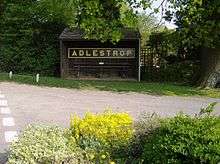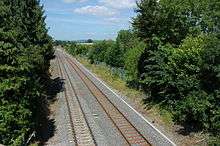Adlestrop

Adlestrop /ˈædəlˌstrɒp/ (formerly Titlestrop or Edestrop) is a village and civil parish in the English county of Gloucestershire. It is known as Tedestrop in the Domesday Book.
The civil parish also includes the village of Daylesford. In the 2001 census the parish had a population of 153,[1] decreasing at the 2011 census[2] to 120.
Description
This small Gloucestershire village deep in the heart of the Cotswolds is renowned for its surrounding countryside and fine walks. Situated off the main A436 road between Stow-on-the-Wold and "The Greedy Goose" near Salford, Oxfordshire, it is a geographically isolated community, with the village post office near the church being the main source of provisions and physical communication. Adlestrop's cricket club plays at Adlestrop Park.[3]
Literary associations

The novelist Jane Austen visited Adlestrop House, formerly the rectory, at least three times between 1794 and 1806, when the occupant was Rev. Thomas Leigh, her mother's cousin. She is thought to have drawn inspiration from the village and its surroundings for her novel Mansfield Park.[4]
Adlestrop was immortalised by Edward Thomas's poem "Adlestrop", which was first published in 1917. The poem describes an uneventful journey that Thomas took on 24 June 1914 on the Oxford to Worcester express; the train made an unscheduled stop at Adlestrop railway station. He did not alight from the train, but describes a moment of calm pause in which he hears "all the birds of Oxfordshire and Gloucestershire". The station closed in 1966; however, the village bus shelter contains the station sign and a bench that was originally on the platform. A plaque on the bench quotes Thomas’s poem. These are the only things that remain of the original station.[5]
Church bells
The five bells of the church of St. Mary were last all rung together in about 1975. The bells lay unrung completely until 2007, when two local couples wishing to marry asked for bells to be rung at their weddings. The bells are:
- Treble (smallest bell), note F: cast in 1711 by Abraham Rudhall (Gloucester)
- 2nd bell, note E flat: cast in 1711 by Abraham Rudhall
- 3rd bell, note D: cast in 1711 by Abraham Rudhall
- 4th bell, note C: cast in 1711 by Abraham Rudhall
- Tenor (largest bell), note B flat (but cracked and toneless): cast in 1838 by Thomas Mears (Gloucester).
The Adlestrop bells are hung in the traditional English fashion. As well as the cracked tenor bell, however, the bell-frame is time expired and suffers from dry rot and woodworm infestation, and the remaining uncracked bells may be rung only very cautiously. The bells were officially listed as "unringable". An appeal, to re-hang the bells and make them fully ringable once more, was launched and the restored bells and frame were rung again for the first time in May 2016.[6]
Gallery
-

Church of St Mary Magdalene
-

Interior of Church of St Mary Magdalene
-

East window and altar, Church of St Mary Magdalene
-

Adlestrop House, formerly the rectory
-

Site of Adlestrop railway station
-

Village shop in Adlestrop
References
- ↑ ONS Census 2001
- ↑ "Parish population 2011.Retrieved 22 March 2015".
- ↑ Adlestrop Cricket Club
- ↑ Adlestrop, Gloucestershire at astoft2.co.uk
- ↑ "100 Years Ago A Train Stopped at Adlestrop Station". Adlestrop village website. Retrieved 28 August 2016.
- ↑ "Dedication service to celebrate success of St Mary Magdalene Adlestrop church bell project". Hereford Times. 26 July 2016. Retrieved 22 August 2016.
Further reading
- Harvey, Anne (compiler & editor) (1999) Adlestrop Revisited: an Anthology Inspired by Edward Thomas's Poem, Stroud: Sutton Publishing ISBN 0-7509-2289-3
External links
| Wikivoyage has a travel guide for Adlestrop. |
| Wikimedia Commons has media related to Adlestrop. |
- Adlestrop and the Cotswolds
- Adlestrop Rectory
- St. Mary Magdalene Church, Adlestrop
- Adlestrop visited by Joseph Gelfer
- 'Parishes: Adlestrop', A History of the County of Gloucester: volume 6 (1965), pp. 8-16.
- Adlestrop: historical and genealogical information at GENUKI.
- Adlestrop in the Domesday Book
Coordinates: 51°56′40″N 1°39′00″W / 51.944333°N 1.65°W